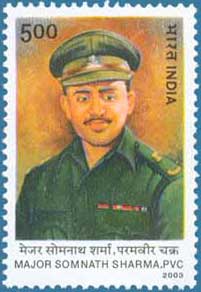
MAJOR SOMNATH SHARMA, PVC

It is oft-proclaimed that national developments are independent of the individual's effort. But it is also true that achievements of some individuals are so towering that they alter the character of a nation. The annals of Indian Military History, for instance, would have had an altogether different story to tell but for Major Somnath Sharma. For the annals would have been devoid of the flaming magnificence of the patriotism of the man that propelled not only his own Company to fight and gain ultimate triumph over the enemy but also inspired generations of soldiers thereafter to serve the country with single-minded devotion even if it meant making the Supreme Sacrifice. No wonder that this was the man who was the first recipient of the Param Vir Chakra, the highest gallantry award.
Born in 1923 in a family of soldiers and doctors, Major Somnath Sharma did his schooling in RIMC Dehradun where he distinguished himself as an all round sportsman and scholar. He gained a competitive vacancy in the Indian Military Academy and was commissioned in 1942 into the 19th Hyderabad Regiment and was posted to the 8th Battalion. He took to the Army like a duck to water, revelling in the challenges of a hard life. The Regiment fought in Burma under the command of Lt. Col. (later General) K.S. Thimayya. There, Major Sharma had a close shave with death when a Japanese hand-grenade landed in his trench but did not explode. He later served with Thimayya as a Major in his staff when the latter got the command of 51 Indian Brigade. Meanwhile, in India, the 8/19th and 4/19th were merged to form the 4lh Kumaon.
In 1947, when tribal raiders were let loose into Kashmir in thousands, Major Sharma's Regiment received an emergency call to join the select force to rescue Kashmir. Though he had broken his wrist and his arm was in plaster, his own 'D' Company was the first to go and after landing at Srinagar, was deployed without pause to stem the enemy advance in Badgam village. The enemy, estimated at 700, attacked his company position with 3-inch mortars, LMGs and rifles. Completely outnumbered and with fire being brought to bear on its position from three sides, the company began to sustain heavy casualties.
Fully realizing the gravity of the situation and the direct threat that would result to both Srinagar and the aerodrome if the enemy attack was not held until reinforcements could be rushed to close the gap leading to Srinagar via Hum Horn, Major Sharma urged his company to fight the enemy tenaciously. He kept rushing across the open ground to his sections, exposing himself repeatedly to heavy fire to urge them to hold on. He skillfully laid out cloth airstrips to guide our aircraft onto their targets in full view of the enemy.
Realising that casualties had affected the effectiveness of his light automatics, this officer, whose left hand was in plaster, personally commenced filling magazines and issuing them to light machine gunners. A mortar shell landing right in the middle of the ammunition resulted in an explosion that killed him. Major Sharma's company still held onto its position and this resulted in the enemy being delayed for six hours, thus gaining time for our reinforcements to get into position at Hum Horn to stem the tide of the enemy advance.
Major Sharma set an example of soldierly qualities seldom equalled in the history of the Indian Army. For his inspiring leadership, fearless courage, unmatched tenacity and self sacrifice, he was posthumously awarded the first Param Vir Chakra, the highest gallantry award instituted by independent India.
Date of Issue: 31.12.2003